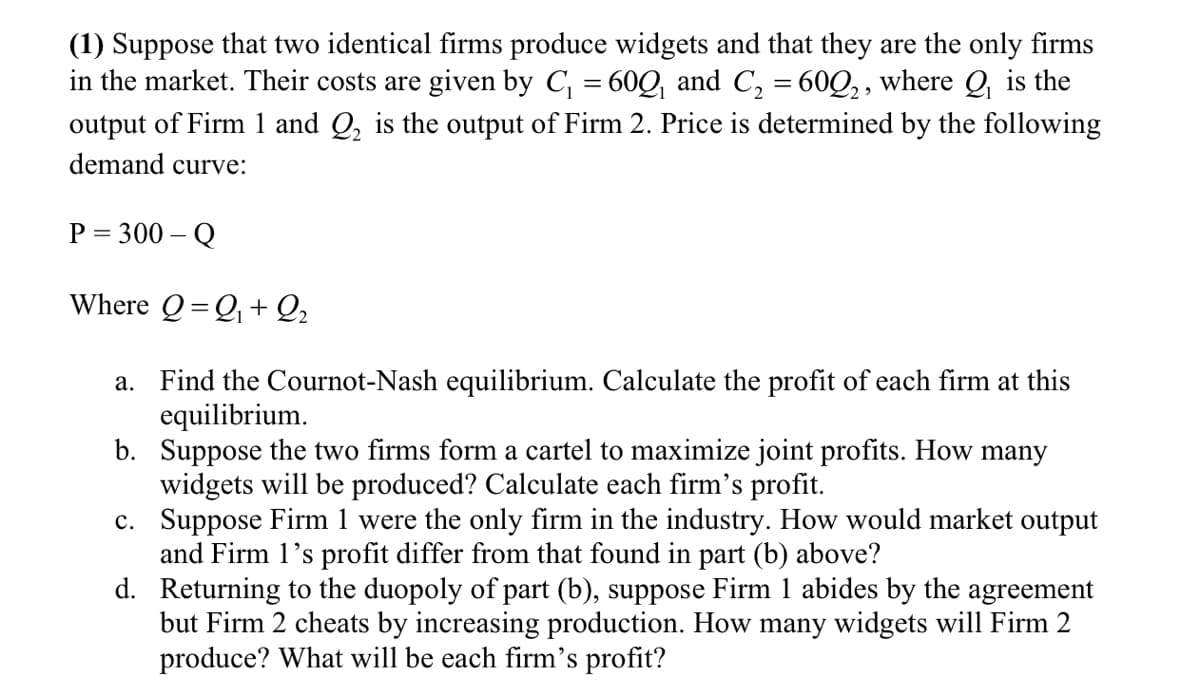(1) Suppose that two identical firms produce widgets and that they are the only firms in the market. Their costs are given by C, = 60Q, and C, = 60Q,, where Q, is the output of Firm 1 and Q, is the output of Firm 2. Price is determined by the following demand curve: P 300 – Q Where Q=Q,+Q. a. Find the Cournot-Nash equilibrium. Calculate the profit of each firm at this equilibrium. b. Suppose the two firms form a cartel to maximize joint profits. How many widgets will be produced? Calculate each firm's profit.
(1) Suppose that two identical firms produce widgets and that they are the only firms in the market. Their costs are given by C, = 60Q, and C, = 60Q,, where Q, is the output of Firm 1 and Q, is the output of Firm 2. Price is determined by the following demand curve: P 300 – Q Where Q=Q,+Q. a. Find the Cournot-Nash equilibrium. Calculate the profit of each firm at this equilibrium. b. Suppose the two firms form a cartel to maximize joint profits. How many widgets will be produced? Calculate each firm's profit.
Managerial Economics: Applications, Strategies and Tactics (MindTap Course List)
14th Edition
ISBN:9781305506381
Author:James R. McGuigan, R. Charles Moyer, Frederick H.deB. Harris
Publisher:James R. McGuigan, R. Charles Moyer, Frederick H.deB. Harris
Chapter12: Price And Output Determination: Oligopoly
Section: Chapter Questions
Problem 1E
Related questions
Question
I need help with a and b

Transcribed Image Text:(1) Suppose that two identical firms produce widgets and that they are the only firms
in the market. Their costs are given by C, = 60Q and C, = 60Q,, where Q, is the
output of Firm 1 and Q, is the output of Firm 2. Price is determined by the following
demand curve:
P = 300 – Q
Where Q=Q+ Q2
a. Find the Cournot-Nash equilibrium. Calculate the profit of each firm at this
equilibrium.
b. Suppose the two firms form a cartel to maximize joint profits. How many
widgets will be produced? Calculate each firm's profit.
c. Suppose Firm 1 were the only firm in the industry. How would market output
and Firm 1's profit differ from that found in part (b) above?
d. Returning to the duopoly of part (b), suppose Firm 1 abides by the agreement
but Firm 2 cheats by increasing production. How many widgets will Firm 2
produce? What will be each firm's profit?
Expert Solution
This question has been solved!
Explore an expertly crafted, step-by-step solution for a thorough understanding of key concepts.
This is a popular solution!
Trending now
This is a popular solution!
Step by step
Solved in 7 steps

Knowledge Booster
Learn more about
Need a deep-dive on the concept behind this application? Look no further. Learn more about this topic, economics and related others by exploring similar questions and additional content below.Recommended textbooks for you

Managerial Economics: Applications, Strategies an…
Economics
ISBN:
9781305506381
Author:
James R. McGuigan, R. Charles Moyer, Frederick H.deB. Harris
Publisher:
Cengage Learning


Managerial Economics: A Problem Solving Approach
Economics
ISBN:
9781337106665
Author:
Luke M. Froeb, Brian T. McCann, Michael R. Ward, Mike Shor
Publisher:
Cengage Learning

Managerial Economics: Applications, Strategies an…
Economics
ISBN:
9781305506381
Author:
James R. McGuigan, R. Charles Moyer, Frederick H.deB. Harris
Publisher:
Cengage Learning


Managerial Economics: A Problem Solving Approach
Economics
ISBN:
9781337106665
Author:
Luke M. Froeb, Brian T. McCann, Michael R. Ward, Mike Shor
Publisher:
Cengage Learning

Exploring Economics
Economics
ISBN:
9781544336329
Author:
Robert L. Sexton
Publisher:
SAGE Publications, Inc

Principles of Microeconomics (MindTap Course List)
Economics
ISBN:
9781305971493
Author:
N. Gregory Mankiw
Publisher:
Cengage Learning

Principles of Economics 2e
Economics
ISBN:
9781947172364
Author:
Steven A. Greenlaw; David Shapiro
Publisher:
OpenStax